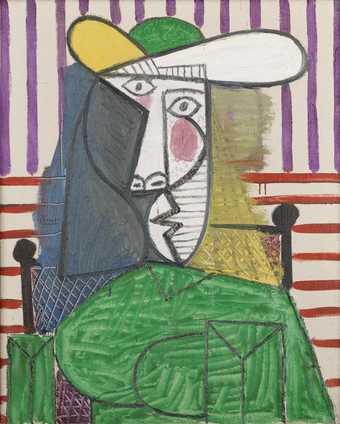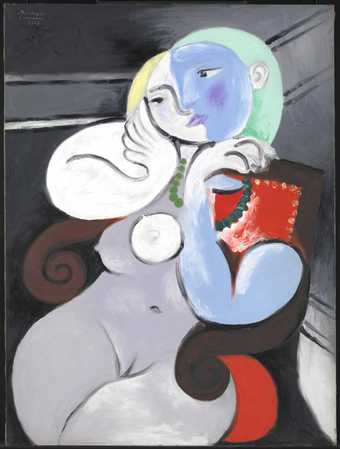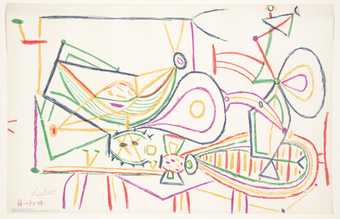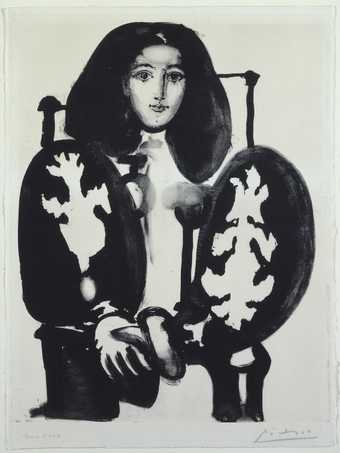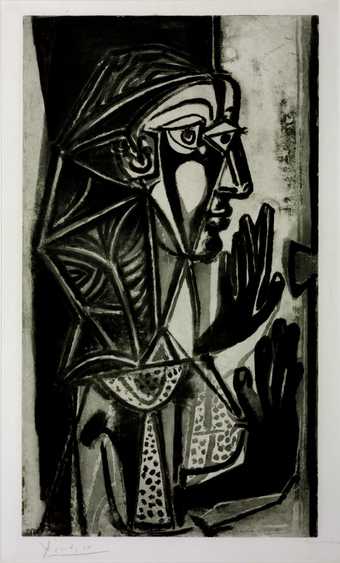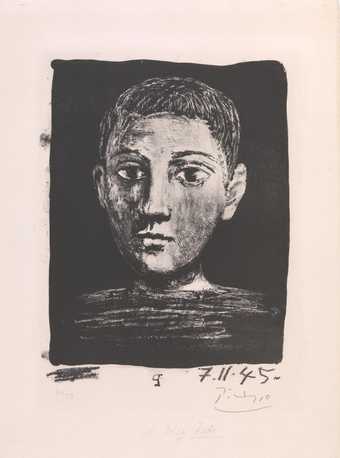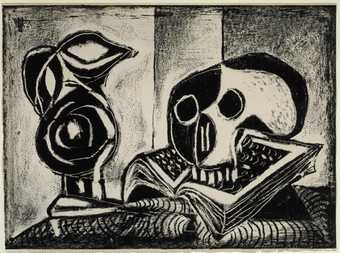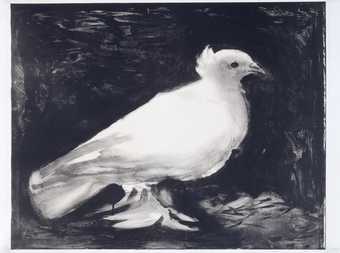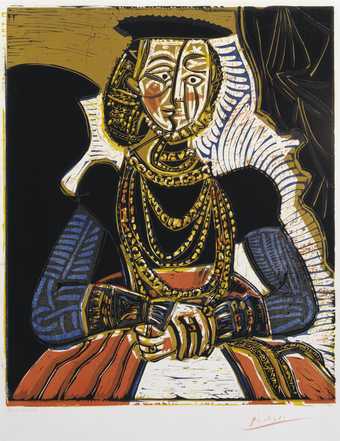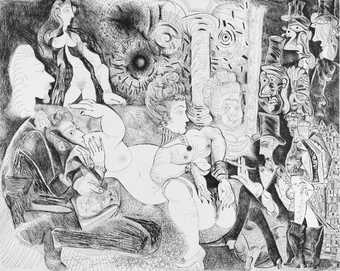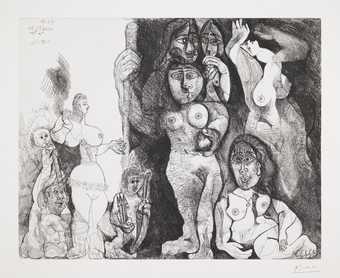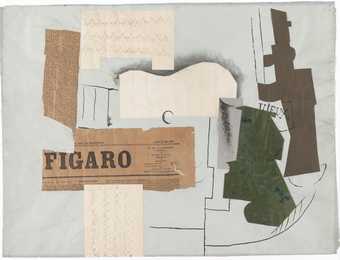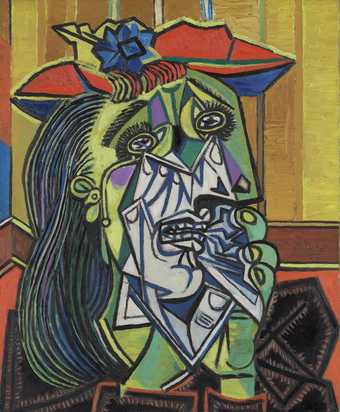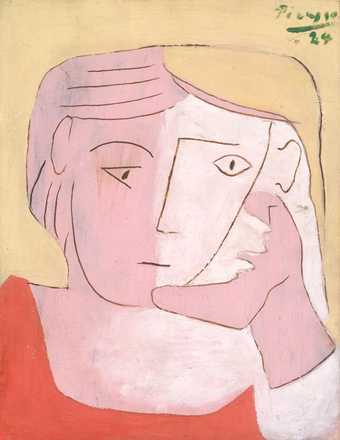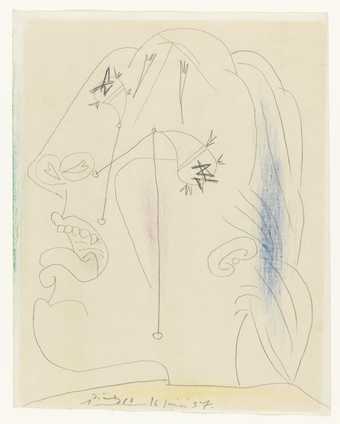
Not on display
- Artist
- Pablo Picasso 1881–1973
- Original title
- Faune dévoilant une dormeuse (Jupiter et Antiope, d'après Rembrandt)
- Medium
- Etching and aquatint on paper
- Dimensions
- Image: 316 × 417 mm
- Collection
- Tate
- Acquisition
- Presented by Gustav and Elly Kahnweiler 1974, accessioned 1994
- Reference
- P11360
Summary
Pablo Picasso’s Faun Revealing a Sleeping Woman is the last print in the series known as the Suite Vollard. This series was the culmination of the collaboration between Picasso and Ambroise Vollard (1865-1939), who had been his first dealer and for whom he had illustrated a number of books. It consists of one hundred prints made in the period 1930-7. Of these, ninety-seven were selected by Picasso and given to Vollard in exchange for a number of his early works; the remaining three were portraits of Vollard. Picasso used a range of techniques in this series, such as etching, aquatint, drypoint, wash, burin and scraper. He depicted a variety of themes, among which the sculptor in his studio and scenes from Greek mythology, particularly relating to the Minotaur, predominate.
The definitive edition of the Suite Vollard was printed in 1939 by the Parisian printmaker Roger Lacourière. It consists of at least two or three artist’s proofs on Montval laid paper, three impressions on vellum paper, fifty impressions on Montval laid paper measuring 500 x 760 mm and 250 impressions on off-white Montval laid paper bearing the watermark ‘Vollard’ or ‘Picasso’.
Made on 12 June 1936, this is the sixth and final state of Faun Revealing a Sleeping Woman. Although the image remained fundamentally the same through the six states, the simple black lines and negligible shading of the earlier states developed into rich tones of grey that depicted a night-time scene with a dramatic play of light and shade. The faun, however, underwent a major transformation, growing more striking and classical-looking with every state, and finally becoming, as Picasso cataloguer Brigitte Baer has described him, ‘a god-like personification of beauty.’ (Baer 1983, p.98.) An intriguing change is in the minor detail of the plant in a pot in front of the balcony: at first a strawberry plant, it eventually turned into basil which, according to Mediterranean folklore, had the magical power to transform animals into wonderful creatures, especially during a full moon.
This print is directly based on Rembrandt’s engraving Jupiter and Antiope, 1659. In Greek mythology, Antiope was a daughter of Nycteus, King of Thebes. Zeus (known as Jupiter in Roman mythology) was attracted by her beauty and came to her in the guise of a satyr (a half-human creature with the horns, legs and hooves of a goat, known as a faun in Roman mythology), after which she conceived twins, Amphion and Zethus. Forced to abandon her children and flee Thebes, she was later brought back to be enslaved by her evil step-mother Dirce. Upon reaching maturity her sons, who had been secretly brought up by shepherds, exacted a terrible revenge upon Nycteus and particularly Dirce, who was tied to the horns of a wild bull.
Many commentators have remarked on the influence that Picasso’s life and circumstances had on his work. Faun Revealing a Sleeping Woman was made as Picasso’s relationship with his lover and muse of ten years Marie-Thérèse Walther was petering out, affection for her having replaced passion. Here the faun – who may be a cipher for Picasso – gently uncovers the sleeping Antiope – who may represent Marie-Thérèse – without disturbing her. This print has been described as ‘a work that looks back nostalgically on their stay in Juan-les-Pins [in April 1936] and on a passion that had changed ... the most successful print in the Suite Vollard and one of the most beautiful in the artist’s engraved work.’ (Baer 1983, p.98.)
Further reading
Brigitte Baer, Picasso the Printmaker: Graphics from the Marina Picasso Collection, exhibition catalogue, Museum of Art, Dallas 1983, reproduced p.99
Brigitte Baer, Picasso Peintre-graveur: Catalogue raisonné de l’oeuvre gravé et des monotypes, 1946-1958, vol.3, Bern 1986, pp.93-98, reproduced p.98
Giorgia Bottinelli, ‘Pablo Picasso’, in Jennifer Mundy (ed.), Cubism and its Legacy: The Gift of Gustav and Elly Kahnweiler, exhibition catalogue, Tate Modern, London 2004, pp.88-90, 92, reproduced p.93
Giorgia Bottinelli
February 2004
Does this text contain inaccurate information or language that you feel we should improve or change? We would like to hear from you.
Display caption
This was the last in the sequence of one hundred prints known as the Vollard Suite. Incorporating a range of techniques, the series often drew upon mythological themes as well as allusions to Picasso’s relationship to Marie-Thérèse Walter. This print is directly based on Rembrandt’s engraving Jupiter and Antiope (1659), in which Jupiter visits Antiope, the daughter of the King of Thebes, in the guise of a satyr or faun. Made as Picasso’s relationship with Marie-Thérèse was petering out, it shows the faun gently uncovering the sleeping Antiope without disturbing her.
Gallery label, March 2011
Does this text contain inaccurate information or language that you feel we should improve or change? We would like to hear from you.
Explore
- architecture(30,960)
- emotions and human qualities(5,345)
-
- desire(149)
- tenderness(70)
- bed(401)
- looking / watching(581)
- sleeping(315)
- female(1,681)
- individuals: female(1,698)
- self-portraits(888)
- classical myths: creatures(143)
-
- satyr(28)
- Antiope(1)
- Zeus / Jupiter(25)
- nationality(18,601)
-
- Spanish(151)
- arts and entertainment(7,210)
-
- artist - non-specific(2,109)
- artist, ceramicist(117)
- artist, draughtsman(674)
- artist, painter(2,545)
- artist, printmaker(610)
- artist, sculptor(1,668)
You might like
-
Pablo Picasso Bust of a Woman
1944 -
Pablo Picasso Nude Woman in a Red Armchair
1932 -
Pablo Picasso Composition
1948 -
Pablo Picasso Woman in an Armchair No.1 (The Polish Cloak)
1949 -
Pablo Picasso Woman at the Window
1952 -
Pablo Picasso Head of a Young Boy
1945 -
Pablo Picasso Black Jug and Skull
1946 -
Pablo Picasso Dove
1949 -
Pablo Picasso Portrait of a Woman after Cranach the Younger
1958 -
Pablo Picasso Etching: 11, 28 February 1970 3, 16, 30 March 1970 (L.13)
1970 -
Pablo Picasso Etching: 19 February 1970 (L.16)
1970 -
Pablo Picasso Bottle of Vieux Marc, Glass, Guitar and Newspaper
1913 -
Pablo Picasso Weeping Woman
1937 -
Pablo Picasso Head of a Woman
1924 -
Pablo Picasso Weeping Woman
1937

